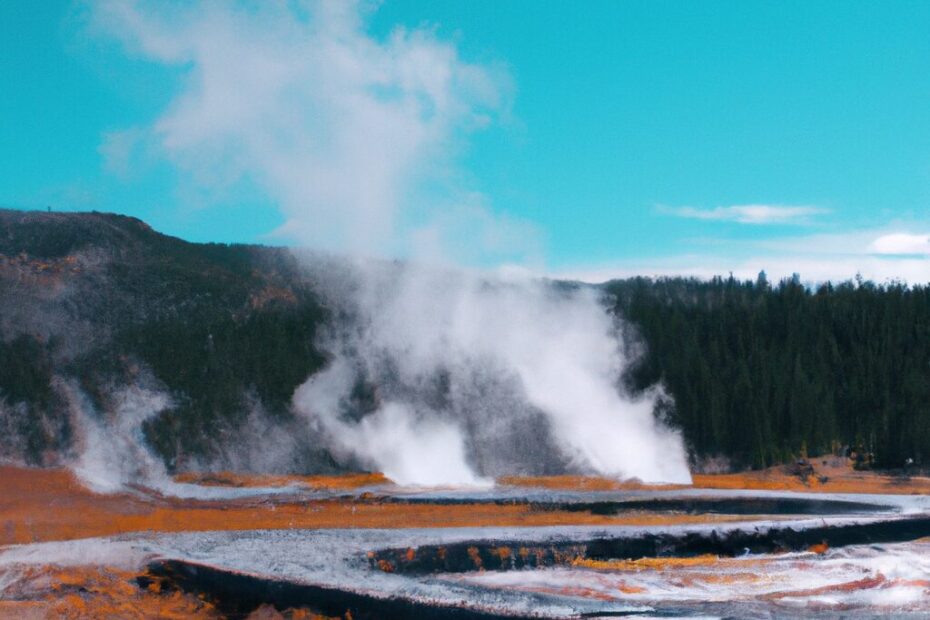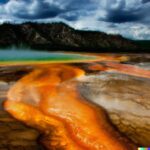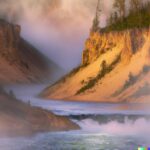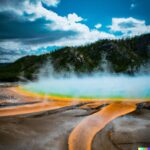Yellowstone National Park, located primarily in the state of Wyoming, is a sprawling natural wonder that captivates visitors with its geothermal features, diverse wildlife, and stunning landscapes. In this article, we will explore the park’s location, size, climate, main attractions, and the best times to visit. Whether you’re interested in witnessing the iconic Old Faithful Geyser, marveling at the vibrant Grand Prismatic Spring, or simply immersing yourself in the park’s natural beauty, Yellowstone offers something for everyone.
What Is Yellowstone National Park?
Yellowstone National Park, located in the United States, is a renowned national park famous for its geysers, hot springs, and diverse wildlife.
These unique natural features of Yellowstone National Park are not only visually stunning but also hold immense geological and ecological significance. The park houses iconic attractions like Old Faithful, which erupts at regular intervals, captivating visitors with its impressive display of water and steam. The Grand Prismatic Spring, with its vibrant colors created by thermophiles, is another must-see sight.
In addition to these wonders, Yellowstone is home to a supervolcano, the Yellowstone Caldera, one of the largest volcanic systems in the world. This supervolcano’s presence adds to the park’s geological significance and serves as a reminder of Earth’s dynamic processes.
Where Is Yellowstone National Park Located?
Yellowstone National Park is located primarily in the states of Wyoming, Montana, and Idaho, nestled within the breathtaking landscapes of the Rocky Mountains.
This expansive park covers an area of over 2.2 million acres, making it not only the first national park in the world but also one of the largest. Its unique position within the Rocky Mountains provides a diverse and dynamic ecosystem, featuring a wide array of geothermal features, including geysers, hot springs, and mud pots. The park’s diverse terrain ranges from lush forests to expansive valleys and towering mountains, offering visitors a visual feast of natural wonders to explore.
State and County
Yellowstone National Park spans across parts of Wyoming, Montana, and Idaho, encompassing diverse ecosystems and natural wonders.
-
The Wyoming section of Yellowstone National Park is home to iconic attractions like the Old Faithful geyser, the Grand Canyon of the Yellowstone, and the picturesque Hayden Valley.
-
Montana’s portion boasts the Lamar Valley, known for its wildlife viewing opportunities, while Idaho’s slice of the park offers serene landscapes and lesser-known thermal features.
-
Each section has its own unique appeal, from geothermal wonders to lush forests and majestic mountains, making a visit to Yellowstone a truly unforgettable experience.
Nearest Cities
The nearest cities to Yellowstone National Park include Cody and Jackson in Wyoming, Bozeman in Montana, and Idaho Falls in Idaho, offering convenient access points to the park’s wonders.
Cody, known as the ‘Rodeo Capital of the World,’ boasts a rich cowboy heritage and features attractions like the Buffalo Bill Center of the West.
Jackson Hole, nestled in the Tetons, offers upscale dining and shopping, as well as easy access to the southern entrance of Yellowstone.
Bozeman, a vibrant college town, is a gateway to the park’s north entrance and is renowned for its outdoor recreation opportunities.
Idaho Falls, with its scenic greenbelt along the Snake River, provides a peaceful retreat after exploring the park’s eastern entrance.
Latitude and Longitude
Yellowstone National Park spans approximately from 44.6 to 45.5 degrees north latitude and -110.1 to -111.2 degrees west longitude, marking its precise geographic coordinates.
These coordinates place Yellowstone National Park primarily in the northwestern region of the state of Wyoming, with smaller sections extending into Montana and Idaho. Situated within this range, the park covers an extensive area of over 2.2 million acres, making it one of the largest national parks in the United States.
The diverse landscape of Yellowstone includes geothermal features like geysers and hot springs, vast forests, lakes, and the famous Yellowstone River. This unique mix of natural wonders attracts millions of visitors each year, seeking to explore its beauty and marvel at its geological phenomena.
Map of Yellowstone National Park
A detailed map of Yellowstone National Park showcases its vast expanse, key points of interest like geysers, hot springs, and wildlife habitats, aiding visitors in navigating the park’s diverse landscapes.
The official map of Yellowstone National Park also highlights essential locations such as Old Faithful, a famous geyser known for its predictable eruptions, and the Grand Canyon of the Yellowstone with stunning waterfalls. Visitors can easily locate the various visitor centers, including the Albright Visitor Center and the Old Faithful Visitor Education Center, to gather information and join ranger-led programs.
The map designates different trails ranging from easy strolls like the Upper Geyser Basin Boardwalk to more challenging hikes like Mount Washburn. Iconic landmarks like Mammoth Hot Springs and Lamar Valley are clearly marked for exploration.
How Big Is Yellowstone National Park?
Yellowstone National Park covers over 2.2 million acres of pristine wilderness, making it one of the largest and most expansive national parks in the United States.
Within this vast area, Yellowstone showcases a diverse range of ecosystems, from majestic mountain ranges to lush forests and geothermal features. The park spans across three states – Wyoming, Montana, and Idaho – offering a rich tapestry of natural wonders. Its wilderness is home to an abundance of wildlife, including grizzly bears, wolves, and herds of bison, contributing to its significance as a symbol of the American West’s untamed beauty.
What Is the Climate of Yellowstone National Park?
Yellowstone National Park experiences a varied climate with cold winters, mild summers, and distinct seasons, offering visitors a different landscape and experience throughout the year.
During the winter months, Yellowstone is transformed into a glistening wonderland, blanketed with snow creating a serene and picturesque setting. The temperature can drop significantly, often below freezing, but this season provides a unique opportunity for activities such as cross-country skiing and snowshoeing.
Spring brings about a burst of color as the park awakens from its winter slumber, with the melting snow giving life to vibrant wildflowers.
Summer in Yellowstone is pleasant, with warmer temperatures making it ideal for hiking, camping, and wildlife spotting, including the chance to see baby animals.
In the fall, the park is painted in hues of gold and red as the foliage changes, offering breathtaking views and excellent opportunities for photography enthusiasts.
What Are the Main Attractions of Yellowstone National Park?
Yellowstone National Park boasts a myriad of attractions, including the iconic Old Faithful Geyser, the vibrant Grand Prismatic Spring, the serene Yellowstone Lake, the awe-inspiring Grand Canyon of the Yellowstone, and abundant opportunities for wildlife viewing.
-
Old Faithful, known for its regular and predictable eruptions, captivates visitors with its towering sprays of scalding water shooting up at intervals. The geyser’s theatrical displays against the picturesque backdrop of the surrounding landscape make for an unforgettable experience.
-
Grand Prismatic Spring, with its vivid colors created by heat-loving bacteria, offers a visual feast that draws photographers and nature enthusiasts alike.
-
Yellowstone Lake, the largest high-elevation lake in North America, provides a tranquil setting for boating, fishing, and enjoying scenic sunsets.
-
The dramatic Grand Canyon of the Yellowstone showcases the power of erosion and the stunning contrasts of yellow rock walls against vibrant greenery.
Old Faithful Geyser
Old Faithful Geyser is one of the most famous geothermal features in Yellowstone National Park, known for its predictable eruptions that occur approximately every 90 minutes, attracting visitors with its natural spectacle.
This iconic geyser plays a crucial role in the geology of the park, as its eruptions are a result of underground water being heated by the Yellowstone hotspot, a geothermal anomaly that fuels the geysers in the area.
Old Faithful’s eruptions can shoot boiling water up to 180 feet in the air, captivating onlookers with its power and beauty. Its reliability and the relatively short wait time between eruptions make it a must-see for visitors, offering a unique opportunity to witness the raw, untamed forces of nature at work.
Grand Prismatic Spring
The Grand Prismatic Spring is a mesmerizing hot spring in Yellowstone National Park, renowned for its vibrant rainbow colors created by microbial mats, offering a captivating sight for visitors.
These vibrant hues, spanning from deep blues to vivid oranges and reds, are a result of the microbial pigments that thrive in the varying water temperatures. The geological formations surrounding the spring, such as the terraces and cones, add to its surreal beauty, showcasing the intricate interaction between nature and geology. This unique ecosystem supports a diverse community of thermophilic microorganisms, highlighting the resilience of life in extreme environments. The Grand Prismatic Spring serves as a living example of the interconnectedness between geology, microbiology, and ecology, making it a focal point for both scientific study and tourist admiration.
Yellowstone Lake
Yellowstone Lake, the largest high-altitude lake in North America, offers pristine waters for fishing, boating, and scenic enjoyment amidst the picturesque landscapes of Yellowstone National Park.
Stretching over 130 square miles, Yellowstone Lake provides ample space for water enthusiasts to explore its shores and tranquil waters. Anglers flock to its waters to try their luck at catching native cutthroat trout, while boaters can spend hours cruising along the lake’s glassy surface. The lake’s beauty is accentuated by the surrounding snow-capped mountains and dense forests, creating a truly mesmerizing backdrop for outdoor adventures. Visitors can also embark on hikes around the lake, marveling at the diverse flora and fauna that call this stunning area home.
Grand Canyon of the Yellowstone
The Grand Canyon of the Yellowstone showcases breathtaking waterfalls, rugged cliffs, and majestic vistas, providing visitors with spectacular hiking trails and iconic viewpoints like Lower Falls and Upper Falls.
These remarkable geological formations were sculpted by the relentless forces of erosion over millions of years, resulting in a landscape of unparalleled beauty. The prominent Lower Falls cascades dramatically into the canyon, plunging down a stunning 308 feet, while the iconic Upper Falls offers a different perspective with its impressive height of 109 feet.
Visitors can explore a variety of well-maintained hiking trails that wind their way through the canyon, offering panoramic views of the colorful rock formations and lush vegetation. Key viewpoints such as Artist Point and Inspiration Point provide unparalleled vistas of the canyon’s natural grandeur, making it a paradise for nature enthusiasts and photographers alike.
Wildlife Viewing
Yellowstone National Park is a prime destination for wildlife viewing, with diverse habitats in areas like Lamar Valley supporting an array of species, contributing to the park’s rich biodiversity and conservation efforts.
The Lamar Valley, often referred to as the ‘Serengeti of North America,’ is particularly renowned for its abundant wildlife sightings, including iconic species like bison, elk, wolves, and grizzly bears. These animals thrive in the varying ecosystems of Yellowstone, from lush forests to wide-open meadows, showcasing the park’s commitment to habitat conservation.
Yellowstone National Park plays a crucial role in preserving biodiversity, serving as a sanctuary for endangered and threatened species while providing a haven for wildlife enthusiasts and researchers alike.
What Are the Best Times to Visit Yellowstone National Park?
The best times to visit Yellowstone National Park are during the spring and fall seasons when the weather is pleasant, the crowds are thinner, and wildlife sightings are abundant, offering a more serene and immersive experience for visitors.
In the spring, the lush greenery starts to bloom, and the temperatures begin to rise, making it an ideal time for hiking and exploring without the scorching heat of summer.
Fall brings stunning foliage as the leaves change colors and the elk begin their mating season, creating magnificent displays for visitors.
Both seasons offer opportunities to witness iconic Yellowstone wildlife, such as bears, wolves, and bison, in their natural habitats, without the large summer crowds.
The lower visitor numbers in spring and fall allow for a more peaceful and reflective experience in this breathtaking national park.
How Do You Get to Yellowstone National Park?
Getting to Yellowstone National Park is accessible through various transportation options, including air travel to nearby airports, road trips by car, bus tours, and scenic train routes that provide convenient access to the park’s entrances and visitor amenities.
Air travel to the Yellowstone region is often a popular choice for visitors coming from afar. Bozeman Yellowstone International Airport and Jackson Hole Airport are two primary airports serving the area, providing convenient access to the park.
For those preferring the flexibility of a road trip, driving to Yellowstone offers the opportunity to explore the surrounding landscapes at their own pace.
Guided bus tours are ideal for travelers seeking a hassle-free way to reach the park while enjoying informative commentary along the journey.
Scenic train journeys, such as the historic Yellowstone Route, allow visitors to experience the beauty of the region in a unique and leisurely manner.
By Air
Traveling to Yellowstone National Park by air involves landing at nearby airports like Bozeman Yellowstone International Airport, Jackson Hole Airport, and Idaho Falls Regional Airport, providing visitors with convenient access to the park’s wonders.
- From these airports, visitors can easily utilize various transportation options to reach Yellowstone National Park. Bozeman Yellowstone International Airport, located around 90 miles from the park, offers car rental services and shuttle buses that can take travelers directly to their accommodations within Yellowstone.
- Similarly, Jackson Hole Airport, situated about 60 miles away, provides rental cars, shuttle services, and private transfer options for a seamless journey to the park.
- Idaho Falls Regional Airport, approximately 110 miles distant, also offers car rentals and shuttle services, allowing visitors to choose the best mode of transportation based on their preferences and convenience.
By Car
Embarking on a road trip by car is a popular way to reach Yellowstone National Park, with scenic routes like the Grand Loop Road offering breathtaking drives through the park’s diverse landscapes and attractions.
Grand Loop Road, spanning 142 miles, is a must-drive route that connects the park’s major sights such as Old Faithful, Yellowstone Lake, and the Grand Canyon of the Yellowstone.
Another scenic option is the Beartooth Highway, renowned for its stunning views and the Beartooth Pass elevation. For a quieter drive, consider the Lamar Valley route, famous for wildlife sightings.
Each road in Yellowstone provides a unique perspective on the park’s natural wonders, showcasing geysers, wildlife, waterfalls, and more along the way.
By Bus
Guided bus tours provide an immersive and informative way to explore Yellowstone National Park, offering visitors a convenient and enriching group travel experience with expert guides and curated sightseeing opportunities.
The guided transportation ensures that visitors can relax and enjoy the stunning landscapes while expert guides provide valuable insights into the park’s geology, wildlife, and history.
Traveling in a group allows for social interaction, creating a sense of camaraderie among passengers who share a common interest in exploring Yellowstone.
The educational aspects of the tours offer visitors a deeper understanding of the park’s unique features and conservation efforts, making the experience both enjoyable and enriching.
By Train
Scenic train routes provide a unique and picturesque journey to Yellowstone National Park, offering passengers a relaxing and immersive travel experience with stunning views of the surrounding landscapes and wildlife.
Traveling by train to Yellowstone allows visitors to sit back and soak in the beauty of the diverse terrain, from lush forests and meadows to majestic mountains and pristine rivers. The rhythmic sounds of the train rolling along the tracks only enhance the sense of relaxation and wonder as travelers pass through charming towns and hidden gems along the way.
The accessibility of train stations near the park’s entrance makes it a convenient and eco-friendly option for those looking to minimize their environmental impact while embarking on this unforgettable adventure.
Last Updated on February 8, 2024 by Jon Waraas – Originally Posted: February 8, 2024

I’m Jon Waraas, and I’ve been navigating the online world since 2006. By day, I’m the proud owner of some eCommerce gems, and by night, I’m the voice behind the adventures on Waraas.Com.
My heart, however, belongs to the wild beauty of Yellowstone National Park. I’ve got a collection of websites dedicated to sharing the wonders of this natural masterpiece. Oh, and did I mention? I’m currently building my own cabin inside the ghost town of Gilmore, Idaho – a cabin with tales to tell!
When I’m not immersed in the digital realm, you’ll find me lacing up my boots for a good hike or setting up camp under the star-studded sky.




